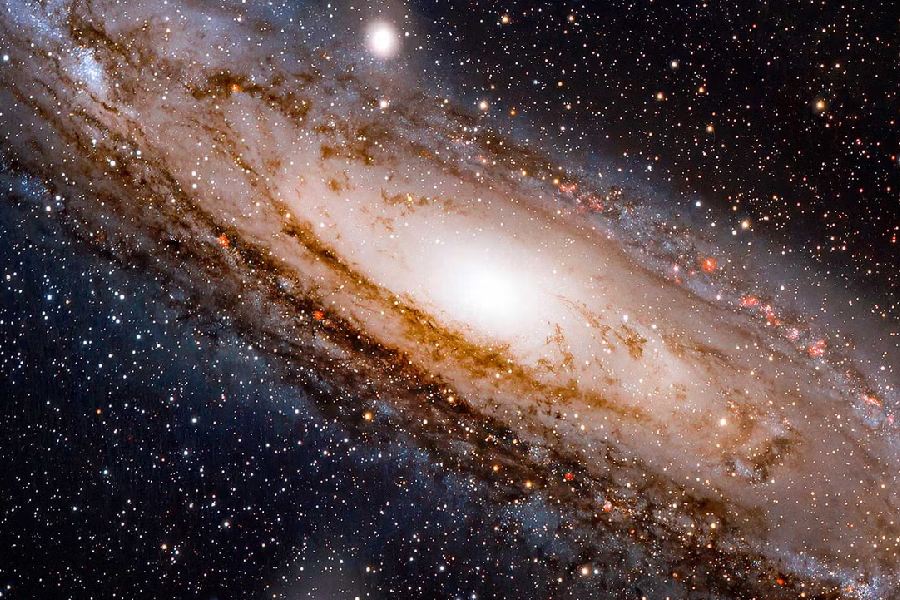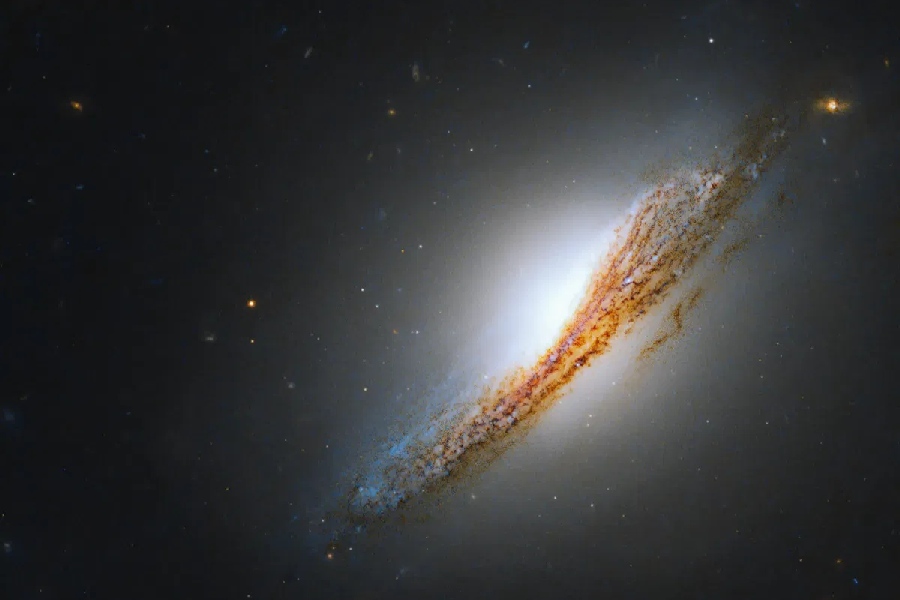Lenticular galaxies stand out as one of the more puzzling cosmic forms scattered throughout our universe. When we gaze at stunning telescopic images of these celestial objects, they exhibit qualities intermediate between spiral and elliptical galaxies. So, what is a lenticular galaxy? How does a lenticular galaxy differ from a spiral galaxy?
In this article, we’ll explore the lenticular galaxy shape and characteristics that distinguish lenticulars from other galactic classes. We’ll also examine their key characteristics, such as their flattened, disk-like appearance and the absence of prominent spiral arms.

What Is a Lenticular Galaxy?
A lenticular galaxy has a flat, disk-shaped form with a bright center, lacking the swirling arms seen in spiral galaxies. These galaxies mainly consist of older stars and have minimal interstellar gas and dust, resulting in less active star formation than spiral galaxies.
Positioned between spiral and elliptical galaxies, lenticular galaxies are often found in galaxy groups or clusters influenced by interactions with neighboring galaxies. This unique type of galaxy displays a distinctive combination of features, adding to the diverse array observed in our vast universe.
Formation and Evolution
Formation processes
Lenticular galaxies often develop from spiral and elliptical galaxies in crowded galactic clusters. They form when spirals lose their interstellar gas, stopping the creation of new stars. The bulges of stars within lenticulars may result from minor mergers involving smaller galaxies in their early stages.
As gas from outside falls into the galaxies, it gets stripped away by the hot intracluster medium. This prevents the formation of new stars as it removes the raw materials.
Additionally, the winds and radiation from the stellar bulges can blow away any remaining gas. Eventually, with no cold gas left, spirals gradually morph into lenticular galaxies.
Merger and interactions
Mergers bring rotational support and stellar content. They can form central bulges, creating lenticular structures. However, frequent mergers can disrupt orderly disks, leading to elliptical formation. Many lenticulars result from gentler environmental interactions.
Also, gravitational encounters in transitioning disk galaxies cause a loss of gas reservoirs. Tidal forces in close passes remove loose interstellar matter, and ram pressure stripping wipes infalling gas as galaxies move through a dense intracluster medium.
Environmental influences
Compact galactic groups and clusters provide an ideal environment for creating lenticular galaxies. The hot gas and frequent galaxy interactions in these regions promote mild collisions and gas stripping, which remove the fuel for star formation. As a result, lenticular galaxies are more likely to form in these dense areas.
Lenticular galaxy properties, such as stellar ages, abundances, and rotational velocities, reflect their histories inherited from ancestral spiral disks. These origins leave lasting kinematic and chemical imprints on the lenticular galaxies.
In addition to mergers and gas loss, environmental factors play a role in shaping lenticular galaxies. Isolated and low-density regions, with fewer interactions, tend to spawn fewer lenticular galaxies. Different assembly histories contribute to the divergence in detailed structure among lenticular galaxies.
Stellar Populations
Dominance of older stars
Lenticular galaxies mainly have old, low-mass stars emitting reddish light. They lack gas and dust for new star formation, making older stars more noticeable. Spectra reveals absorption lines from cooler red giant branch stars nearing the end of their evolution.
Compared to spirals with hot blue stars, lenticulars appear monochromatic and uniformly reddish, unlike ellipticals, which often show signs of past mergers. The color of lenticulars suggests stability for billions of years as the initial disk stars keep aging.
Limited star formation compared to spiral galaxies
Lenticular galaxies rarely see new stars being born because their gas density remains consistently low. Galactic winds and environmental interactions in the past have cleared away the materials needed for star formation.
The presence of white dwarf stellar remnants adds to the suppression of star production by emitting ultraviolet and releasing gases. This results in lenticular galaxies having an old, passive stellar population, indicating that they have settled into a stable equilibrium state.
Without the disruptive forces of turbulent photon pressures or stellar explosions from young stars, lenticular galaxies’ rotational motions and overall structure remain extremely stable. This characteristic sets lenticular galaxies apart as one of the most dynamically inert types of galaxies known.

Characteristics of Lenticular Galaxies
Shape and structure
Lenticulars have flat circular stellar disks similar to spiral galaxies but lack noticeable spiral patterns due to an abundance of aging stars. Occasionally, a faint barred shape appears near the disk centers.
These galaxies have central ellipsoidal bulges that extend above and below the disk midplane. These bulges likely formed through mergers with smaller galaxies and now emit a reddish glow from their aged stellar contents.
In contrast to spirals actively producing hot, young stars, lenticulars lose the cold interstellar gases necessary for prominent spiral arms over time. Their smooth, featureless disks remain preserved from their spiral progenitors. Without turbulent star-forming regions, no spiral waves emerge.
Composition
Lenticulars mainly have old, low-mass stars, aged over 10 billion years, spread across the disk and bulge. Despite this, detailed observations reveal some central stellar light reflecting residual star formation up to 2 billion years ago.
The remaining interstellar material is close to stellar bulges, where gravity tightly holds gases. However, trace abundances rule out the possibility of new star formation. The overall scarcity of gas ensures a stable global dynamic equilibrium.
Classification
In Hubble’s classification, lenticular types exist in the transition zone between elliptical and spiral galaxies. They have a dual disk and bulge, not fitting perfectly into either category.
This intermediate zone effectively shows their position between active spirals and inert ellipticals. Lenticulars have stabilized, aging stellar disks like spirals and faint residual star formation near bulges. They sit between actively forming and fully quiescent galaxies.
Their visual traits stem from evolutionary pathways disrupted by environmental interactions. Understanding their context helps clarify their place among the diverse cosmic objects.
Observing Lenticular Galaxies
Astronomical techniques
Optical telescopes pinpoint lenticular galaxies with their disk shape and red shifted bulges. Color imaging highlights aging stellar populations in the disks due to the absence of star formation.
Spectroscopy reveals rotational velocities, indicating dynamic equilibrium. However, optical bands can’t unveil stars hidden by central dust remnants.
Infrared wavelengths, longer than optical, penetrate central dust, exposing bulge stars more effectively. Thermal infrared also maps the dust distribution.
Moreover, radio emissions trace neutral atomic hydrogen gas remnants, not visible in optical observations. Combining data from various spectrums comprehensively explains lenticular galaxies’ composition and kinematics.
Notable lenticular galaxy examples
The Sombrero Galaxy (M104)
The Sombrero Galaxy has a unique bulge encircled by a bright, thin dust ring resembling a Mexican hat. Infrared observations show that this dust ring emits strong light originating from the surrounding dust envelope of the bulge.
This lenticular galaxy also possesses an extended stellar halo beyond its central region. Within this halo are globular star clusters, suggesting past minor mergers. These ancient mergers played a role in gradually building up the galaxy’s central mass over time.
NGC 5866 (the Spindle Galaxy)
NGC 5866 is a slender lenticular galaxy seen edge-on from Earth. It has a flat outer disk in an elliptical form. This galaxy, one of the closer and larger lenticular examples, is a model for studying the characteristics of stellar bulges and disks. This helps in defining the entire lenticular class in detail.
The Role of Lenticular Galaxies in the Universe
Cosmic environments
Lenticular galaxies are mostly found in crowded places like compact groups and rich clusters. In these areas, the hot gas within the group or cluster and frequent gravitational encounters tend to transform spirals into lenticulars. While some lenticular galaxies exist on their own, they are less common.
The evolution of lenticular galaxies is often driven by regular tidal interactions with nearby cluster members. Close flybys and mergers play a role in reshaping spirals into the distinctive lenticular structure by removing gas. Additionally, forces such as ram pressure stripping and harassment by other galaxies contribute to maintaining the gas-poor nature of present-day lenticular specimens.
Stellar dynamics
Stellar disks are characterized by smooth rotational support, contrasting with the prevalence of randomized motions in bulges. Echoes of late star formation manifest through distinctive localized velocities.
Lenticular galaxies, emerging from the multi-billion-year aging of initial spiral disk contents, signify an overall calm equilibrium in their dynamical states. Notably, these galaxies exhibit a lack of violent gas cloud collapse or bursty star formation, distinguishing them as the most dynamically stable late-type galaxies identified to date.
The longevity of lenticular galaxies surpasses that of spirals, which are capable of star formation. Lenticulars gradually evolve into inert elliptical shapes, indefinitely maintaining a sustained equilibrium configuration. This enduring stability further solidifies the distinctive nature of lenticular galaxies in the cosmic tapestry.
Conclusion
What is a lenticular galaxy? A lenticular galaxy is a type of galaxy that falls between spiral and elliptical galaxies, characterized by a central bulge but lacking spiral arms. Exploring these galaxies has provided a deeper understanding of their distinctive transitional nature.
By examining various characteristics, ranging from their disk-shaped profiles to the aging stellar inhabitants within, we gained valuable insights into the evolutionary pathways that guide the transformation of spiral galaxies into intermediary forms. The absence of prominent ongoing star formation or spiral arms in lenticular galaxies makes them particularly valuable subjects for study.
Their inherent stability and quiescence offer significant rewards as they allow us to unravel the gradual changes in galactic structure. This, in turn, enables us to unlock insights into the underlying physical processes that shape our universe over its vast lifespan.
